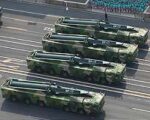The U.S. Army has awarded a $51 million contract to AM General for the production of new High Mobility Multipurpose Wheeled Vehicles (HMMWVs), commonly known as Humvees. The procurement aims to enhance the service’s tactical mobility capabilities as it continues balancing legacy platforms with the rollout of the Joint Light Tactical Vehicle (JLTV).
Contract Details and Scope
On September 25, 2025, AM General announced it had received a $51 million order under an existing multi-year Indefinite Delivery/Indefinite Quantity (IDIQ) contract with the U.S. Army Contracting Command – Detroit Arsenal. The order covers the production of over 300 new M1151A1B1 HMMWVs configured primarily for troop transport and general utility roles.
The M1151A1B1 variant features an Expanded Capacity Vehicle (ECV) chassis designed to accommodate increased payloads and modular armor kits under the Integrated Armor Protection System (IAPS). These vehicles are expected to be delivered between Q2 and Q4 of FY2026 and will support both active duty and National Guard units.
Strategic Role of Humvees in Current Force Structure
Despite being gradually replaced by the more survivable JLTV platform developed by Oshkosh Defense, Humvees remain a critical component of the U.S. Army’s tactical vehicle fleet due to their versatility, lower operating costs, and widespread global use.
The Army operates an estimated 120,000+ Humvees across various configurations—ranging from ambulances to command-and-control variants—and continues to rely on them for missions where high-end protection is not required but mobility is essential. The newly procured vehicles will likely replace aging units that have surpassed their service life or been heavily worn through overseas deployments.
Balancing JLTV Transition with Operational Demands
The JLTV program aims to replace approximately one-third of the current Humvee fleet with more survivable platforms featuring improved blast protection and integrated C4ISR systems. However, full fielding remains years away due to budgetary constraints and production pacing.
In March 2023, AM General won a major contract to produce up to 20,000 JLTVs over five years after taking over from Oshkosh Defense in a competitive rebid process valued at up to $8.66 billion. While JLTVs are prioritized for frontline combat units such as Infantry Brigade Combat Teams (IBCTs) and Special Operations Forces (SOF), legacy HMMWVs continue filling mobility gaps in support elements and rear-echelon formations.
Export Potential and Partner Nation Support
In addition to domestic use, newly produced HMMWVs may also be allocated through Foreign Military Sales (FMS) or Excess Defense Articles (EDA) programs as part of U.S. security cooperation efforts abroad. Over two dozen allied nations operate various HMMWV models—many seeking replacements or upgrades amid increasing operational tempo in Eastern Europe and Africa.
- Ukraine has received hundreds of refurbished HMMWVs since early 2022 under EDA transfers supporting its defense against Russia’s invasion.
- Baltic states have requested additional wheeled platforms compatible with NATO logistics chains.
- African partners such as Kenya and Tunisia continue using HMMWVs in counterterrorism operations supported by U.S.-funded training missions.
AM General’s Production Capacity and Modernization Strategy
AM General maintains robust manufacturing capacity at its Mishawaka facility in Indiana where both legacy HMMWV lines and future JLTV production are being integrated under modernization initiatives launched after its acquisition by KPS Capital Partners in mid-2020.
The company has invested significantly in digital engineering tools, automation upgrades, and supply chain resilience measures aimed at sustaining dual-platform production while reducing lifecycle costs for military customers worldwide.
Conclusion: Bridging Capability Gaps Through Incremental Procurement
This latest $51 million award underscores how incremental procurement strategies remain vital as militaries navigate long-term modernization timelines constrained by fiscal realities. For the U.S. Army—still engaged globally from Europe to Indo-Pacific theaters—the continued use of upgraded Humvees provides a cost-effective bridge until next-generation tactical mobility solutions reach full operational maturity across all echelons.









